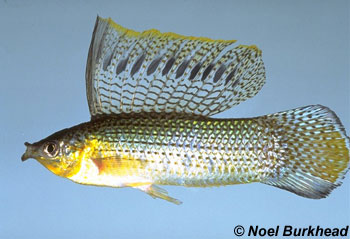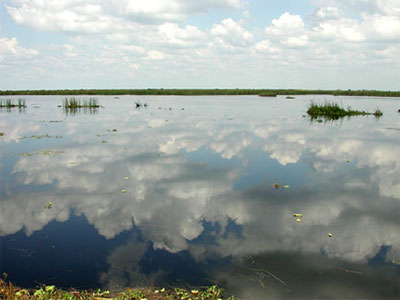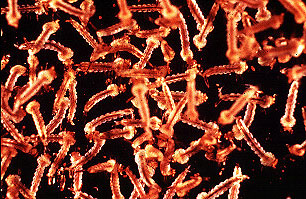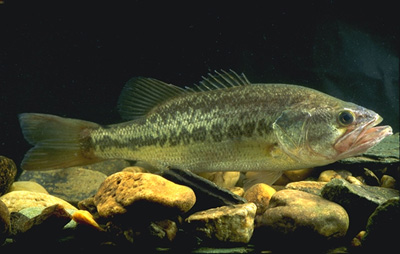Sailfin Molly

Poecilia latipinna
These small, oblong fish are generally gray with rows of spots that almost blend to look like stripes. Males have an enlarged dorsal fin, but otherwise they have small fins in general, including a truncated caudal (tail) fin. Their upturned faces help them draw from the upper layer of oxygen-rich water, allowing them to thrive in poor quality water. They can be found in ponds, marshes, and even roadside ditches, and they are popular with aquarists, who have bred a wide variety of colors with this tolerant fish.
Order – Cyprinodontiformes
Family – Poeciliidae
Genus – Poecilia
Species – latipinna
Common Names
Sailfin molly, Breitflossenkärpfling (German), bubuntis (Tagalog), Molinezja szerokopletwa (Polish), molliénésie á voilure (French), and tabai (Hawaiian).
Importance to Humans

The sailfin molly, in its many color varieties is of considerable interest and value to aquarists and many artificially selected varieties are produced and sold in pet shops. Naturally occurring populations of sailfin mollies may help to control mosquito populations by feeding on the larvae and pupae of these pests.
Conservation
This species is not listed as threatened or vulnerable by the World Conservation Union (IUCN). The IUCN is a global union of states, governmental agencies, and non-governmental organizations in a partnership that assesses the conservation status of species.
> Check the status of the sailfin molly at the IUCN website.
Geographical Distribution

The sailfin molly is found in fresh, brackish, and coastal salt water in coastal lowland habitats from North Carolina to Texas and the Yucatan Peninsula of Mexico. Prefering marshes, lowland streams, swamps, and estuaries, the sailfin molly is very common in peninsular Florida. Non-indigenous populations are established in the western U.S. and in Hawaii. Sailfin mollies introduced to California have caused a decline in populations of the federally endangered desert pupfish (Cyprinodon macularius).
Habitat
Sailfin mollies are most commonly observed in the shallow surface waters along the edges of marshes, lowland streams, ponds, swamps, estuaries and even ephemeral water bodies such as roadside ditches. Small to large aggregations of the species are most commonly found under floating vegetation or near structures in the water, minimizing their chances of being observed by potential predators.
The sailfin molly is a tolerant species. By exploiting the thin film of oxygen rich surface water with their upturned mouths, sailfin mollies are able to survive oxygen depleted habitats. A euryhaline species, the sailfin molly may be found in a variety of saline environments and will breed in brackish waters.
Biology

Distinctive Features
The body of the sailfin molly is essentially oblong. The head is small and dorsally flattened, with a small, upturned mouth. The caudal peduncle is broad and the caudal fin is large, rounded, and sometimes tipped with black. The pelvic fins originate at a point anterior to the dorsal fin. The dorsal fin is greatly enlarged in mature males and somewhat enlarged in females. It is this conspicuous and attractive feature that lends the species its prevailing common name.

Coloration
The body is generally light gray, although breeding males may be greenish-blue. Several rows of spots occur along the sides, back, and dorsal fin. Often times these spots blend together or are very close to one another, creating an appearance of stripes. Aquarists have developed many color variations in this species, and indeed much variation occurs naturally in the wild, with melanistic and speckled forms known.
Dentition
Sailfin mollies possess many rows of very small teeth, the outer row of which are the largest.
Size, Age, and Growth
The natural lifespan of sailfin mollies, like other small poeciliids, is short, particularly in the case of the males, which may live less than one year after achieving sexual maturity. Depending upon environmental conditions sailfin mollies may become reproductively in less than a year. Sailfin mollies are small fish. At one year of age males typically range in size from 15-51 mm SL while mature females are likely to be approximately 19-53 mm SL. The sizes of adult males is directly correlated with population density. The greater the population, the smaller the average size of males. The maximum recorded size for this species is 150 mm TL.

Food Habits
Sailfin mollies feed primarily upon algae and other plant materials, although they will consume a number of aquatic invertebrates including the larvae of mosquitos.
Reproduction
Female sailfin mollies tend to be larger than males, a disparity typical of the Poeciliidae. Males exhibit large and colorful dorsal fins in addition to a colorful caudal fin and these conspicuous secondary sexual features play a role in female mate choice. Fertilization is internal and is accomplished by means of highly modified fin elements within the anal fin of males that form a structure known as the gonopodium. Sailfin mollies produce broods of 10-140 live young, depending upon maturity and size, and females may store sperm long after the demise of their relatively short-lived mates. The gestation period for this species is approximately 3-4 weeks, depending upon temperature, and a single female may give birth on multiple ocassions throughout the year. Although sex ratios of the broods are balanced, adult populations tend to be largely female as males appear to suffer higher rates of mortality due to a greater susceptibility to predators and disease as a consequence of their showy breeding dress and a life spent largely in a frenzy of breeding. There is no parental care exhibited by this species.

Predators
Sailfin mollies are small, numerous members of the lower end of the food chain. As such they are prey for numerous animals including aquatic insects, other fishes, reptiles and amphibians, birds and mammals. Specific examples of such creatures include, giant water bugs (Belostomatidae), largemouth bass (Micropterus salmoides), American alligator (Alligator mississippiensis), bullfrog (Rana catesbeiana), snowy egret (Egretta thula), and racoon (Procyon lotor). Parasites
The haploplorid trematode, Saccocoelioides sogandaresi is a known parasite of the sailfin molly.
Taxonomy
The sailfin molly was originally described in 1821 as Mollienesia latipinna by the naturalist Charles Alexandre Lesueur, oft noted as one of a number of persons instrumental in the founding of a well known experimental settlement at New Harmony, Indiana during the 1820’s. Lesueur based his description of the sailfin molly upon specimens from freshwater ponds in the vicinity of New Orleans, Louisiana. However, Lesueur described other collections of the sailfin molly as Mollienesia multilineata in 1821, the same year in which he described M. latipinna. This conflict created confusion and eventually necessitated a ruling by the International Commission on Zoological Nomenclature (ICZN). In 1959, the ICZN placed precedence on the name Mollienesia latipinna Lesueur 1821.
A number of other synonyms exist, most of which are based on specimens from other areas of the sailfin molly’s rather large native range. These include Limia poeciloides Girard 1858, Poecilia lineolata Girard 1858, and Limia matamorensisGirard 1859. In a landmark work on poeciliid fishes, Donn Rosen and Reeve Bailey (1959) noted the priority of PoeciliaBloch and Schneider 1801 with regards to Mollienesia Lesueur 1821, thereby relegating Mollienesia to the synonymy of Poecilia. Consequently, the proper binomial for the sailfin molly is Poecilia latipinna (Lesueur, 1821).
Prepared by: Robert H. Robins